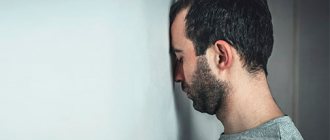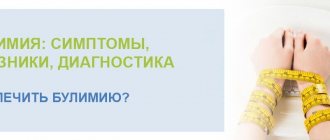What is phagophobia
The name literally translates as “fear of eating.” Phagophobia is an irrational, panicky fear of swallowing something. Popular shapes:
- fear of swallowing food;
- fear of swallowing saliva;
- fear of swallowing pills.
A person is afraid of experiencing unpleasant sensations, choking and dying. There are different types of fear of swallowing. For example, some people are afraid only of solid food, while others are afraid of drinking water, still others are afraid of choking when swallowing pills, and still others are afraid of absolutely everything related to swallowing.
Note! Phagophobia can be confused with anorexia. In both cases, the person is afraid to eat, refuses food, and loses weight. But in the first case, this is associated with the fear of choking, and in the second case, with the fear of gaining weight.
Swallowing disorders
The generalized concept of “swallowing disorders” describes functional disorders of the acts of eating and swallowing. The following syndromes have psychosomatic significance:
- swallowing air (aerophagia),
- difficulty swallowing with or without a feeling of pressure in the throat,
- swallowing disorders with vomiting (so-called vomiting neurosis).
Psychophysiology. What is common to swallowing disorders is that the act of swallowing, which occurs as a reflex process with successive relaxation and muscle tension, can no longer be regulated, although there are no organic reasons for this.
Vomiting is an innate protective function in animals and humans, which eliminates harmful substances through antiperistalsis. In humans, this is often associated with an affect of disgust.
Reasons for fear of swallowing
Most often, phagophobia develops against the background of the fact that one day a person actually choked. A feeling of suffocation, accompanied by pain in the chest and throat, coughing, dizziness, and rapid heartbeat can frighten anyone. The brain quickly remembers this incident, because the inability to take a full breath is perceived as a direct threat to a person’s life.
Other reasons for fear of swallowing food:
- Intimidation by parents. “Don’t play around, or you’ll choke,” “Don’t talk while eating, or you’ll choke,” etc. Or one day the child choked, and he was more frightened by the parents’ reaction (they shouted, swore, flogged him).
- Impressionability. Perhaps someone told the person a story about someone else choking on food and dying. Or such a scene was in the film, they wrote about it on a social network, etc.
- Primary mental disorders, tension, stress. This condition can cause involuntary muscle contractions, which can lead to problems with swallowing.
- Aversion to certain foods or to food as such. Perhaps the person tried something unpleasant and the memories still cause a spasm. Or the phagophobe was overfed as a child.
- Severe throat disease. Perhaps due to illness, any meal caused discomfort in the throat. The illness passed, but the fear remained.
Interesting! In rare cases, phagophobia is caused by hormonal imbalance in the body.
Doctors' advice
Sitophobia is a serious disorder that must be treated promptly. The combination of drug treatment and psychotherapy gives a good result, noticeable after 1-2 months. Having achieved a reduction in the symptoms of the disorder, the psychotherapist gradually leads the patient to understand the need for a balanced and timely diet.
If a small child or teenager is faced with a problem, the parents’ task is not to criticize eating behavior, but to encourage the child. In other words, for every piece of solid food eaten, doctors recommend praising the child, and not reproaching him for eating so little.
It is almost impossible to overcome sittophobia on your own, since drug therapy plays an important role here. In this regard, it is necessary to consult a doctor as soon as possible, before the problem develops into a severe mental disorder.
Signs and symptoms of fear of swallowing
A phagophobe avoids canteens, get-togethers with friends, and family dinners. To eat food, he chooses quiet places and solitude. Remember how closely food is associated with communication: business negotiations in a cafe, meeting with an old acquaintance, someone’s birthday, etc. A person has to either give up all this or carefully plan his menu and take liquid preparations. But how to explain all this to other people, how to get away from their obsessive offers to try something?
In general, the phagophobe gradually isolates himself within the walls of the house. He creates a “safe” menu (each phagophobe has his own). First, the phagophobe refuses foods such as fish, then all solid foods. Each meal lasts a very long time, since the phagophobe needs to tune in, and he also chews each piece very slowly (he even tries to eat liquid food a little at a time).
A phagophobe is frightened by one type of solid food. When contacting an object of fear, a number of somatic reactions occur:
- nausea,
- vomit,
- headache,
- dizziness,
- chills,
- arrhythmia,
- tachycardia,
- feeling of suffocation and coma in the throat,
- irritability,
- desire to run away.
In some cases, due to tension, a phagophobe experiences a spasm of the swallowing muscles. Because of this, a person can actually choke. However, a medical examination does not find gastrointestinal pathologies. In this case we are talking about psychosomatics: a person scares himself, somatic reactions are a consequence of a phobia.
Note! Even before eating, a person begins to feel suffocated. Against this background, he may have a panic attack. At such moments, the individual becomes dangerous to himself and others.
How to get rid of phagophobia
How to get rid of the fear of swallowing pills, food, water? In the treatment of phagophobia, psychologists use an integrated approach: psychotherapy and medications. Medications include antidepressants, sedatives and anti-anxiety drugs. Among the methods of psychotherapy, hypnosis, cognitive behavioral psychotherapy, psychoanalysis, and art therapy have a positive effect.
How to get rid of phagophobia yourself as an adult
Is it possible to get rid of the fear of swallowing (phagophobia) on your own? Yes, use the anchoring technique. The idea is that you choose a positive trigger that helps you relax enough to swallow the product or pill calmly. Now in more detail:
- remember a situation when you felt as calm as possible (choose the feeling you want to experience instead of anxiety and fear);
- choose something from the outside world (sound, smell, object) that you associate with this state of calm;
- look at the object (another action depending on the selected trigger) and consciously reproduce that pleasant situation;
- Feel it as much as possible at the level of thoughts, body, soul.
Exercise regularly during your free time and before you need to swallow anything. Soon you will only need to look at the trigger and a state of calm will come naturally.
On forums you can find the following advice on how to overcome the fear of swallowing food and choking:
- Chew food slowly and thoroughly (you can start with soft foods and gradually move on to hard foods);
- remind yourself, convince yourself that nothing bad will happen;
- face your fear in practice as often as possible;
- Get a support group, eat in company.
You can get acquainted with the responses of psychologists and psychotherapists to the form at this link. Experts analyze a real situation from a request from a client who once choked and is now afraid to swallow.
And here you will find an analysis of another real case of phagophobia - tips on how to get rid of the fear of swallowing food from the forum of psychologists, reviews from specialists.
Another discussion on the request “Phagophobia and OCD: help.” Review from a psychologist, discussion of medications for phagophobia.
What to do if your child is afraid to swallow food
How to treat phagophobia in a child? What to do if he is afraid to swallow food:
- do not focus on the problem;
- do not force the child to eat;
- create the safest and most positive psychological atmosphere around the child;
- invite your child to eat from a spoon, from your hands, even if your child has been eating on his own for a long time (“remember how you and I used to eat together,” “mom is nearby, everything is fine”);
- Offer to eat what the child likes most (you can start with liquid food and move on to solid food);
- offer to play “tasting”, “astronaut”, “restaurant”, etc.
Art therapy has a good effect in the treatment of phagophobia in children. Draw fear with your child, sculpt it from plasticine. In this case, the object will be the object that the child once appeared with and then became afraid of.
The causes and manifestations of the fear of swallowing food in children are no different from the fear of swallowing in adults.
Other eating disorders
Allotriophagy
– a specific disorder associated with eating inedible substances of a nonbiotic nature (sharp metal or glass objects, bolts, pins), in a mild form, occurs in pregnant women (chalk, cardboard) as a consequence of endointoxication. This disorder is common in adulthood and may occur due to unhealthy appetite.
Diabulimia
– Patients with insulin-dependent diabetes deliberately take an insufficient dose of insulin or stop taking it completely in order to lose weight.
Drankorexia
(“alcohol diet”) – meals are replaced by drinking alcohol with the intention of controlling body weight or losing weight.
Orthorexia nervosa
– obsessive eating only healthy foods.
Selective eating disorder
– refusal to eat a certain type of food, limiting the names of foods that can be eaten, refusal to try new foods, preferences in color, shape or type of food.
Pregorexia
– a specific eating disorder in pregnant women, manifested in a conscious refusal to eat in order to maintain a slim figure, the adoption of various tricks to hide a growing belly and not gain weight, and exhausting sports activities.
Among the possible causes of eating disorders, there are somatic (metabolic disorders, hormonal imbalance leading to impaired serotonin uptake, dysfunctional disorder of satiety mechanisms), affective (distress, depression), social (stereotypes and values in society), personal (parental influence , family situation, personality traits). In any case, each eating disorder requires an integrated approach to treatment and joint patient work of the patient and specialists - physiologists, nutritionists and psychotherapists.
Why is fear of swallowing dangerous?
The most dangerous complication of the fear of swallowing is cybophobia (the fear of swallowing). If there is a fear of food, then it is not far from exhaustion. Moreover, we are talking about both physical exhaustion and psychological burnout. A phagophobe develops secondary mental disorders and problems: sleep disorders, depressive tendencies.
Interesting! Often, OCD (obsessive-compulsive disorder) develops against the background of a fear of swallowing. A phagophobe comes up with a ritual that supposedly protects him while eating.
Alternative Treatments
Treatment of phobias by a psychotherapist often takes a long time. To achieve a stable positive result, psychotherapy is supported by alternative treatment methods. These include:
- art therapy (painting with paints or sand, sculpting, playing musical instruments);
- meditation, reading mantras;
- healthy lifestyle, physical activity;
- breathing exercises;
- use of self-hypnosis techniques.
Another way is to try to focus your attention on something distracted while eating. When food hits the root of the tongue, it triggers a reflexive swallowing reflex. Don't disturb your body by focusing on your fear. At first it will work out poorly, but over time this tactic will yield results.
Related posts:
- Paranoid schizophrenia Mental disorders are distinguished by a variety of clinical manifestations. Some diseases are temporary...
- Causes of Depression in Children Depression is a mental illness marked by persistent feelings of sadness, irritability, loss...
- Schizophrenia: features of treatment of the paranoid form Paranoid schizophrenia of a continuous type combines several forms of this illness,…
- What causes sleepwalking? Sleepwalking, somnambulism, sleepwalking - this condition has many names, but...










